
2024 edit.
This post is currently being edited. Below, a video on the first part of the explanation.
You can check the method out with the image below. Dowload it here. You can use a program like Paint to overlap the bomb scheme on the first page of the letter and slide it.

Prologue
In the summer of 2017, I knew a man named Joe Bevilacqua.
Joe was an 81-year-old Italian-American from New Jersey. In his 20-year career in the United States Army, he had served as a chemical instructor and CID investigator, having been awarded the Silver Star and other medals during the war in Vietnam.
[Click here for the second part]
In 1994, Joe testified about the “Monster of Florence” case in the Pietro Pacciani trial. At the time of Monster’s homicides, Joe resided in the area of activity of the serial killer, near Florence. The last crime took place near his home, the local American war Cemetery, where he worked as superintendent.
One afternoon in August, while we were on the balcony of Joe’s house, an apartment overlooking the “highway of the sun” and the Chianti hills, I showed him a copy of the first page of the letter from Zodiac with serial killer’s encrypted identity.
Joe took the letter and began to read aloud, translating each line into Italian. When he reached the thirteen symbols, he smiled: “Forget it.” He paused on the line below the cipher.

“Io sono moderatamente ceroso…” he translated in Italian.
“Strange sentence”, he said, “Why did he write ‘ceroso’ instead of ‘curioso’?”. Joe’s tone hinted that the mistake could have some relevance.
A few weeks later, wondering why my elderly “suggester” underlined the word “cerous” (with the Italian meaning of “waxy”), I realized that it was maybe a key to solve the puzzle (see chapter L’acqua).

I noticed another detail, during the first attempts to decipher the message. In the 1988 edition of the Oxford English dictionary, the word “Aeneid” and the main character of Virgil’s poem, “Aeneas”, were the only words starting with “Aen”[1], like Zodiac’s cipher. Could there be a connection?
That classic reading was more useful for revealing a disguise weared by the serial killer than how it was in helping to find his name (see chapter Take the money and run).
The references used by Zodiac to build the cipher

After three years, I believe I have come to identify all the pieces of the coding method of the 13 letters encrypted by Zodiac. It will be seen that, apart from ancient symbols and terms, the references used by the murderer to encrypt his name were popular at the time the message was written.
Links to the letter (FBI specimen)
How the cipher is made
Zodiac’s name is not encrypted with a substitution code. The symbols are part of a puzzle game.
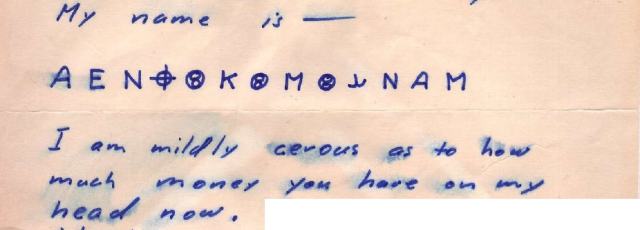
The cipher
In the letter to the San Francisco Chronicle postmarked on April 20, 1970, Zodiac claimed to have encrypted his name in the row of 13 symbols on the first page. Immediately upon receiving this communication, the San Francisco Police Department asked the FBI to break the code, but the Bureau’s specialists were unable to[2]. The text was too short.
The Army Security Agency and Criminal Investigation Division were of the opinion that Zodiac had received military training in cryptography[3]. If it were true, the author should have known that the message of 13 symbols could not be “cracked” without clues similar to that he would have inserted in his Halloween card, a few months later[4] (the letter Q, according to the solution I posted here).

LOOKING FOR CLUES
On first page of the letter, Zodiac asked readers if they had already decrypted the 340-character encrypted message he mailed a few months earlier. He said he was “cerous” – instead of curious – to know the amount of his reward. He nicknamed the policemen “blue meanies (sic)”, like the Beatles antagonists in the movie “Yellow submarine”. He added that he was not the perpetrator of a recent bombing on a police station, although he claimed there was “more glory” in killing a cop than a “cid” – misspelling of “kid” child.
Zodiac also told the readers he “was swamped by the rain”.
In the previous letter to Melvin Belli he had said: “I am drownding (sic)”. Did he mean he lives in a not very dry place?
On second page, the killer had drawn a diagram of a bomb he was threatening to detonate, describing how it would work.
1. ANETHEKE
The first block of the cipher consists of an ancient Greek word in capital letters depicted in the book “The Alphabet” by Frederic W. Goudy, ANETHEKE, erected (or dedicated), recognizable by the particular shape of the Theta, similar to a solar cross. It is an inscription from a temple of Poseidon located at Cape Taenarum, in Laconia, Greece[5] (this find was first published by zodiackiller.com).
Zodiac made three changes to the original inscription. He transposed N and E, inserted a solar cross in place of the Theta, replaced the second and third E with a circled 8.

The name and symbol that Zodiac used to sign himself were probably copied from the watch brand “Zodiac”.
The Zodiac most advertised product in the late 1960s was the Sea Wolf diving watch, publicized in 1967 as follows:
“A skin’s diver watch?
The only time
I am under water is
in the shower.”[6]
The similarity between the Theta in the inscription of the temple of Poseidon and the solar cross may explain why the author of the cipher text replaced one with the other.
Due to its symbolic importance, the solar cross could encipher an initial.
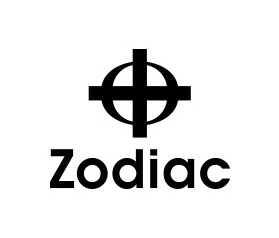
Archaeologist James Whitley, Cambridge University, explains how the word “anetheke” is translated into English:

James Whitley, The archaeology of ancient Greece, p. 140
The reason Zodiac used the word ANETHEKE in its cipher is related to the way his code was made. In fact, this ancient Greek word is translated as the word “set up”[7], that is the same verb the author of the cipher used on page 2, in the preamble of the explanation on how he “set up” the ” bomb”.
What Zodiac intends to suggest using ANETHEKE and the verb “set up” could be: “My name is – set up like this”.
The diagram below with the sun, the road and the bus could indicate the method for deciphering the “My name is-cipher”.
Decryption method hinted by ANETHEKE

2. Let the sunshine in
The sentence “the bomb is set up like this” based on the ANETHEKE – set up connection, suggests that the name of Zodiac is “set up” as the schematic of the bomb indicates.
If the diagram is superimposed on the cipher (you may drawn it on tracing paper) as in the image below, by placing the solar circle on the I of “is”, the arrows will indicate an empty space under the symbol ⑧ and before the word “cerous”, the bus just below the cipher.

The decryption of E, I and the discovery of the key word ICE

By moving the diagram of the bomb (above, to highlight the concept I only move the bus) along the encrypted text (you can also use Microsoft Paint or a similar program), you’ll find three possible translations in correspondence with the symbols ⑧ that allow you to start the decryption.
You can do that using the image at this link
I and E
The seventh letter of the cipher is an I, which is shown under the decrypted symbol.
Moving the diagram horizontally in correspondence with the first ⑧, the fifth letter will be an E.
Ice
The virtual movement of the “bus” vector along the path designed by Zodiac highlights the decrypted letters as the product of the “collision” between the bus and the first of the two arrows coming from the sun.
In the case of the third ⑧, as indicated by the second arrow (in red), if the dash is translated over the word “cerous”, the elision of “rous” is obtained, which, coupled with the projection of the “i”, generates the word ICE.
The application of this procedure explains why Zodiac has misspelled a commonly used word that he could hardly not know, “curious”, in “cerous”.
The keyword ICE can be a tip for decrypting the third ⑧.
Let the sunshine in
Why apply the “sunbeam” deciphering system only to the symbol ⑧? Because, immersed in the cultural context of San Francisco dating back to when Zodiac wrote the letter, the decryption system of this part of the message seems to allude to a very famous “zodiacal” theme song by the Fifth Dimension released in that period, “Aquarius-Let the sunshine in”, taken from the equally famous musical “Hair”, the bible of hippy culture.
The “Hair” symbol is an “8” prominently featured in advertising at the time. Zodiac, may have copied the symbol and added a circle (the sun?) to differentiate it from a common “8”.

Why does Zodiac, instead of writing “my bounty amount”, include a convoluted sentence in the paragraph below the cipher that ends with:

“Aquarius-Let the sunshine in” by The Fifth Dimension is a 1969 single with which the American band won the Grammy Award for “recording of the year”[9].
The musical piece of the group is an arrangement of “Aquarius” and “Let the sunshine in”, two songs of the musical “Hair”[10], which was performed at the Geary Theater, in San Francisco, a few steps from the corner of the street where the Zodiac stopped the taxi driven by Stine[11], the same day he was killed, on October 11, 1969[12].
In 1969-1970, the pacifist musical was so successful (as was Fifth Dimension’s “Aquarius-let the sunshine in”) that it was still staged in San Francisco, at the Orpheum theater, when Zodiac sent his name enciphered[13].
On the posters of “Hair” were depicted two mirror faces in the shape of 8. The same symbol in horizontal position appeared above the “i” of “Hair” also in advertisements[14].

Department of Justice, Zodiac Homicides Special Report, 1971
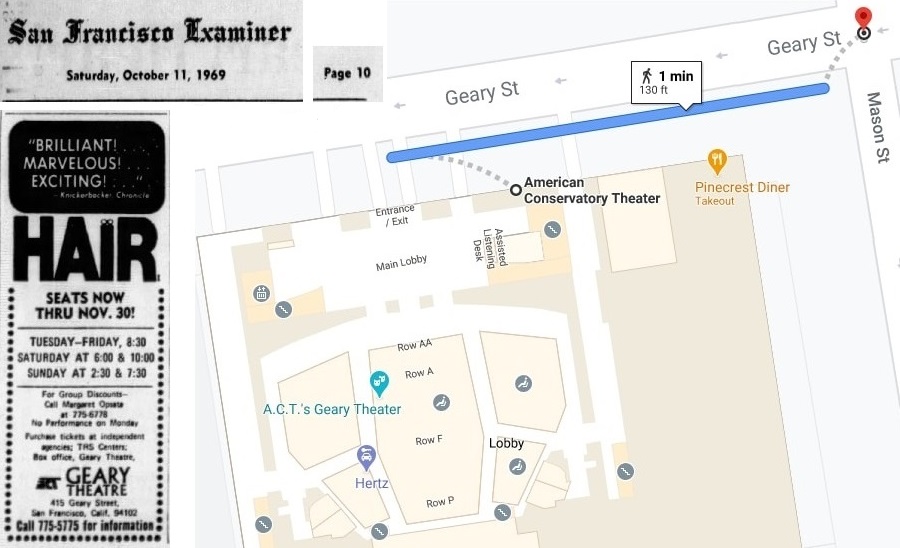
Donna
“Let the sunshine in” is the last song sung in the musical “Hair”, while the first song is “Aquarius”, followed by “Donna”, a name of a possible Zodiac’s victim who disappeared on the coast of Lake Tahoe, near the state line with Nevada, September 6, 1970[15].
In a postcard dated March 22, 1971, the serial killer seems to allude to his responsibility for the disappearance[16].
It is worth noting an important allusion by Zodiac in reference to “Hair” and dating back to October 5, 1970, about a month after the death of Donna Lass.
In the postcard in which Zodiac claimed crime number 13 (below), there is a visible peculiarity. Let’s identify it before reading the next paragraph.
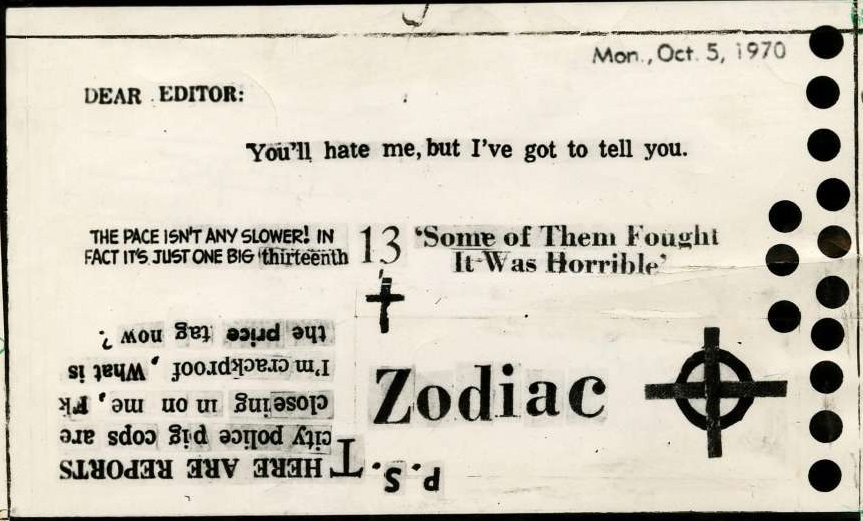
Zodiac composed the message with newspaper clippings (which he had never done before), gluing a part of it upside down. For what reason?
The answer is in the pages of the San Francisco newspapers of that period used to make the postcard, definitive confirmation of the goodness of the lead followed.
Before the postcard was sent on October 5, in the days of Donna Lass’s disappearance, the advertisements for “Hair” appeared with the title upside down, probably to attract the attention of the reader who had seen those ads for more than a year.
“Hair, the musical that turned Broadway upside down”
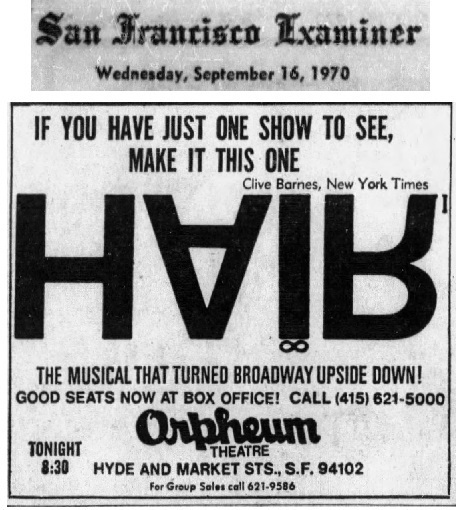
Another clipping on the back of the postcard, the address “San Francisco Chronicle”, taken from Datebook, the insert dedicated to cultural events that came out in the Sunday edition in combination with the Examiner, is a useful proof of the readings of Zodiac confirming two of the next parts of the decryption.
Letters so far decrypted

3. L’acqua – water
Like the word ANETHEKE, the anchor-shaped symbol before NAM also comes from an ancient civilization. This is the Brahmi letter “Ya”.
Searching on the Internet (starting from Wikipedia) for text published before the cipher was made, this letter is found accompanied by a symbol similar to Zodiac’s ⑧ only in a depiction of an ancient seal of Harappa that appeared on an old book.
The Harappa seal

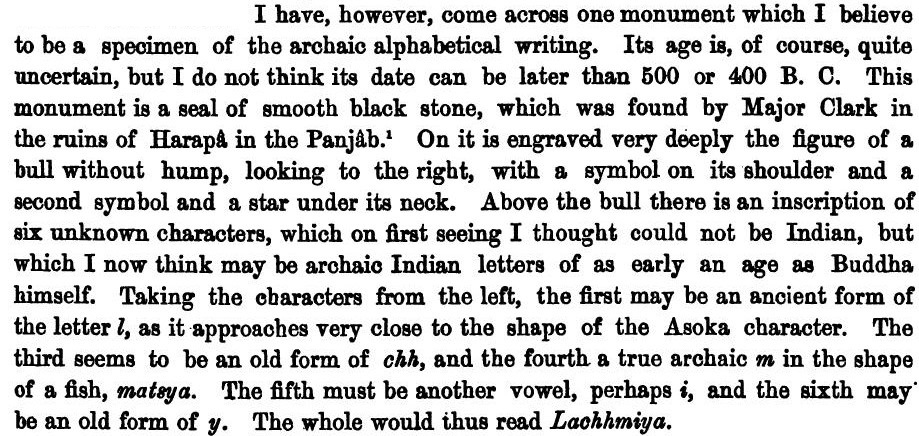
Alexander Cunningham, Corpus Inscriptionum Indicarum, p. 61
The lithography of the seal depicted above accompanied by four Brahmi symbols was published in the “Corpus Inscriptionum Indicarum” (Indian inscriptions) by the archaeologist Alexander Cunningham[17].
The YA used by the Zodiac in its row of 13 symbols was part of the name “Lachhmiya”, an attempt by Cunningham to translate the unknown symbols in the seal.
The symbols MI and YA referred to in the cipher

MI and YA appear anagrammed in the first two letters above and below the encrypted message: “My” and “I a”. The respective Brahmi symbols, the “almost” 8 (circled like the symbol of “Hair”) and the “anchor”, are found in the cipher in the same order as they were found in Cunningham’s book.
A few months after sending the encrypted Zodiac name, a Halloween card signed by the serial killer arrived on the desk of Paul Avery, the Chronicle reporter following Zodiac’s infamous deeds. On that card appeared a new and mysterious symbol that researchers of the case have related to the cattle brand of Red Ryder, main character of the homonymous western comic, which appeared on the n. 15 cover.
Maybe it is a clue.
The two symbols mentioned, highlighted below in red, have in fact something in common. In both cases, they refer to a “mark” on a bull.
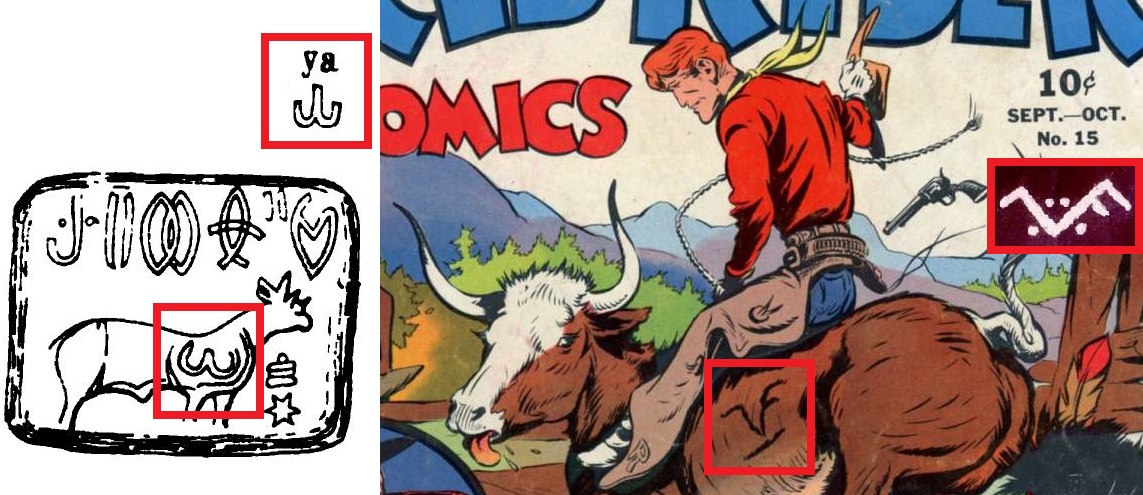
Why was Zodiac inspired by the Harappa seal?
The scribbler serial killer read western comics, listened to popular music, went to the theater, the cinema, and evidently frequented the dustiest corners of libraries.
Only three letters separate Cunningham’s C and Goudy’s G, author of “The Alphabet”. Zodiac may have pulled their works from the same shelf in the “archeology” section of some university in or around San Francisco.
ANETHEKE makes sense. It is seen at the beginning of the decryption. But why would the Zodiac choose to refer to Harappa seal in that part of the cipher? For translating a letter of his name with YA? Or does the symbol perform a function analogous to ANETHEKE? “Lacchmiya” is just a name. What should it indicate?
How to solve this puzzle?
I think it would have been impossible without the help of Joe, the elder Italian-American I met in Florence in 2017.
I remember a few days after that summer talk on Zodiac’s cipher I laid down reflecting on what I had been told, repeating to myself: “Why did he dwell on ‘cerous’? Why did he insist on its weirdness?”
Then, I was reminded of an adage by English writer Gilbert Keith Chesterton: look at the world “upside down” to see better.
I turned the cipher and started looking at the symbols slowly translating them into my advisor’s name.

From that perspective, the letters “lac”, which ended at the Cunningham symbol, were exactly below “cerous”, that in Italian means “waxy”.
The seal stone, “waxy”…
What if “sealing wax” had been the key?
In the chapter “Bekim”, the explanation of the presence of the M.
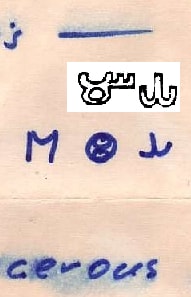
The Lac
In English, “cerous” is related to the metal “cerium”[18], while in Italian it is widely used in reference to “wax”.
There is no connection between the meaning of “cerous” in English and the cipher. The question would change if “cerous” derives from the Latin etymology “cera”, wax[19]. It is possible that “cerous” means “waxy” as in Italian and Latin[20]. Joe translated it in this sense, in fact.

Taking for granted the interpretation of the term “cerous” given to me by the old Italian-American who highlighted its strangeness, “sealing wax”[21] (“ceralacca” in Italian) is the most immediate combination of words between “waxy” and the Harappa seal from which Zodiac got the anchor symbol.

The main component of the sealing wax is a mixture called “shellac” consisting mainly of “lac”[22], a resinous substance which is secreted by the cochineal Kerria Lacca.
In past centuries, sealing wax was used in combination with a seal to close mail envelopes and to certify documents[23].
LAC is also the first part of the name “Lachmmiya” from which Zodiac took the symbols MI and YA.
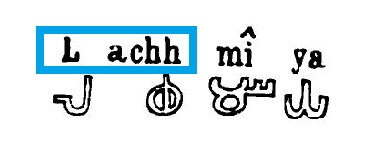
Could LAC be the text ciphered by the symbols above “cerous”?
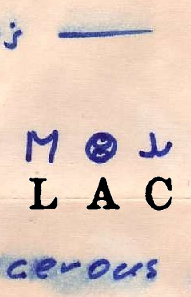
If the decryption is correct, the third ⑧, formed by the disk of the sun and the 8 of “Hair” and/or the “almost 8” in the representation of the seal of Harappa, would imply a connection between the A of LAC and ICE.
What could be the connection between the letter A and ICE?

L’acqua, the water?

The decryption of the sequence ILAC through the song “Aquarius-Let the sunshine in” and the Harappa seal is useful not only to find the reason why Zodiac connected A to ICE, but to identify almost all the solution, an eventuality that certainly the author of the message had not foreseen.
Nowadays, to find it, all you need is an online search in the Census Bureau datasets (download file B in the linked page).
List of all surnames containing ILAC in the 2010 US census[24]

With a representation of 2667 people, which reaches almost 70 percent of the total, the most common surname containing the sequence ILAC in the United States is Bevilacqua[25]. This surname, in addition to corresponding to the letters identified so far and to the number of letters remaining in the final part of the decryption, contains the Italian word ACQUA[26], that is the most elementary connection to the term ICE and, at the same time, offers an explanation to the Zodiac’s choice to use the Fifth Dimension song “Aquarius-Let the sunshine in” to encrypt this part of his name.
The A is connected to the word ICE as the first letter of ACQUA, water, the last part of Zodiac’s name.
In the 2010 United States Census data, it turns out that the primacy of surnames ending with ACQUA also belongs to BEVILACQUA.It represents more than a third of the total, surpassing the second in the ranking, PASSALACQUA (1410), by almost double.

Highlighted in red, the most important data: only BEVILACQUA and ILACQUA are part of the set of surnames that contain the sequence ILAC and end in ACQUA in the United States[27].
On balance, this means that, if Zodiac is a living American citizen and the decryption so far is correct, it is very likely that his surname is BEVILACQUA (90 percent).

Fifth Dimension’s “The age of Aquarius” cover

4. Qua-nam

The last part of ACQUA is QUA. A connection with NAM is to be found out.
[Click here for the first part]
Between QUA and NAM there could be a logical link similar to LAC and the symbols of the seal of Harappa and “cerous”. If so, QUA and NAM would have a correlation with the underlying phrase, “as to how”.
Consulting a Latin dictionary, you may find the existence of the entry QUA-NAM, which corresponds to the union of the last part of the cipher text and the possible solution[28].
The dictionary quotes a sentence from the Naturalis Historia by Pliny.
“It is a mystery how dolphins can hear”[29]

QUA-NAM is a Latin word that means “how”. Therefore, the phrase underlying the last part of Zodiac’s name could be a tip.
Pliny’s sentence about dolphins, present in almost all the Latin dictionaries in which “quanam” is found (not reported here for brevity), is only the last of the many references to water encountered during the decryption, purposely colored in blue. Below is the complete list:
- ANETHEKE, inscription in a temple of Poseidon, god of the Sea
- The diving watch “Zodiac Sea Wolf“
- The word ICE
- The song “Aquarius-Let the sunshine in”
- Pliny’s sentence on dolphins’ hearing
It was seen that the letter contains two other references to water in clear text: “Blue Meanies”, who are the Beatles antagonists in the movie “Yellow Submarine”, and the phrase: “I was swamped out by the rain”.
That “flood” of citations is consistent with a surname ending with ACQUA.
Furthermore, as for the “almost 8” of Harappa, also the part of the decryption of Zodiac’s name relating to the word “acqua” is compatible with the solution of the riddle of the Halloween card.
In the next image, you can see the “death wheel” depicted on the cover of “Tim Holt” #30 (top, left) from which Zodiac almost entirely copied the inscriptions on the last page of the Halloween card (right).
It is possible to glimpse a fifth sentence on the wheel, not copied by Zodiac, partially hidden by the head of the comic’s protagonist, Redmask.
The sentence is “death by water”.
Is “by water” Zodiac’s real signature?

The references to water must have been very important to Zodiac. In his last attributed letter postmarked January 29, 1974, instead of signing himself with his nickname, he enigmatically, Zodiac quoted a passage about a drowning taken from “The Mikado” by Arthur S. Sullivan and William S. Gilbert[30]:
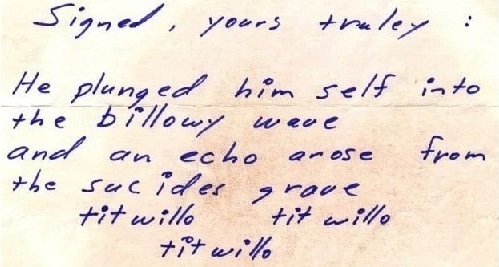
To know more about the “water theory”, click here.
5. Bekim
At this point of the decryption:
- Five letters, E, ILAC and one keyword, ICE, were identified;
- Through a search in the data of the 2010 US census, a list of only eight surnames with the sequence ILAC was identified;
- It turned out that only two of those surnames, BEVILACQUA and ILACQUA ended with the word ACQUA, compatible with the number of symbols available and whose meaning was immediately linked to the underlying keyword ICE and to the decryption method based on the hit song of the 1969 by Fifth Dimension, “Aquarius-Let the sunshine in”. This solution is also consistent with the “water theory”;
- Clearly more common between the two surnames and also compatible with the position of the remaining decrypted letter, the E, is BEVILACQUA, which, if the decryption so far is correct, has a 90 percent probability of being Zodiac’s surname.
It is noted that the origin of the M in the cipher is not yet known.

Four sources of the Zodiac code have been identified, the symbol 8 of the musical Hair, the inscription ANETHEKE, the Bhrami symbols MI and YA in a reproduction of a seal of Harappa and the Latin word QUA-NAM.
Sources indicate that the Zodiac had a passion for ancient civilizations and archeology. The publications from which he drew the ancient words, in fact, are not popular, but niche products. They can be found in the dustiest sectors of old libraries.
On the other hand, the murderer also follows the cultural events of his time, at least in the newspapers, as evidenced by the references to Hair and the Fifth Dimension, as well as the clipping of the address of the postcard of 5 October 1970, taken from the cultural insert of the San Francisco Chronicle and Examiner, Datebook (image below).
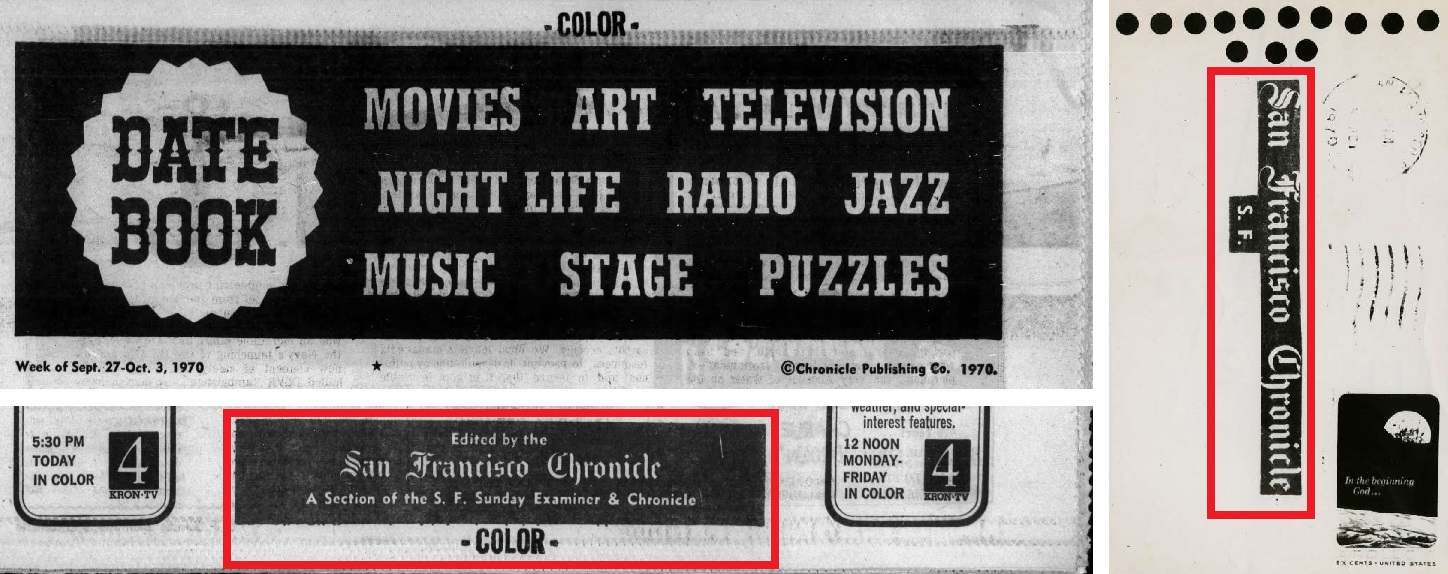
The source of M is therefore expected to belong to one of those two groups. How to know which one? It is a single letter and may have been selected from any code or cultural reference.
The M, however, should also have a specific purpose in the context of this encryption. And that’s what we need to identify. To do this, you need to relate it to the other parts of the code.
After some tests, it can be easily observed that once the symbols ⑧ have been decrypted, the insertion of the M generates the EKIM sequence.

A search for the term “ekim” in the 1970 newspaper editions on the website newspapers.com[31] resulted in the recurring name “Bekim” of Serbian-Albanian actor Bekim Fehmiu.
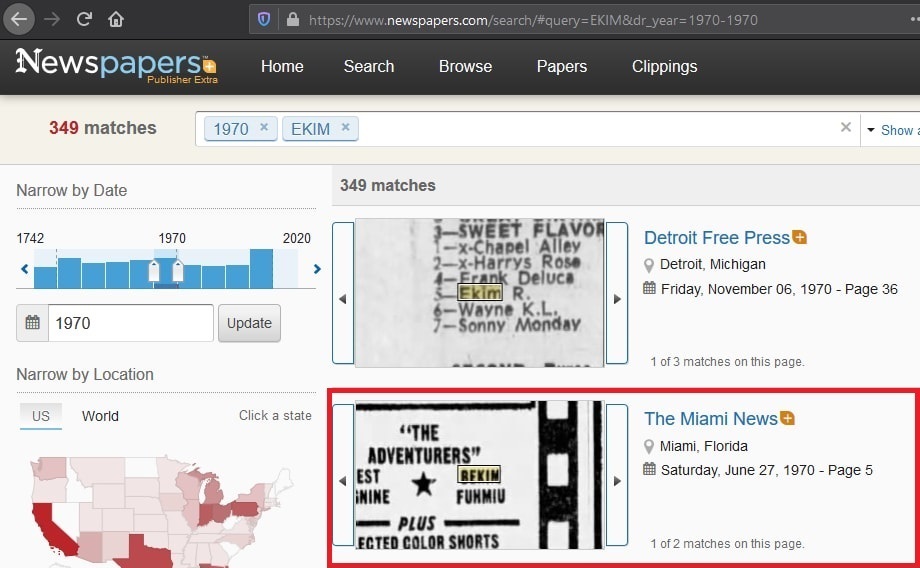
Fehmiu had become famous in some European countries thanks to his interpretation of Ulysses in the Italian TV series “Odyssey”, which was broadcast for the first time on the Italian RAI channels in 1968[32].
To learn more about the importance of the figure of Ulysses for the solution of the Zodiac case, click here.
A movie titled “The Adventurers” with Fehmiu as the protagonist, Dax Xenos, and Candice Bergen as his wife[33] was screening at the “Alexandria” cinema and in several other cinemas/drive-in in San Francisco and the Bay Area, before[34], after[35] and during (next image) the sending of the encrypted Zodiac’s message.
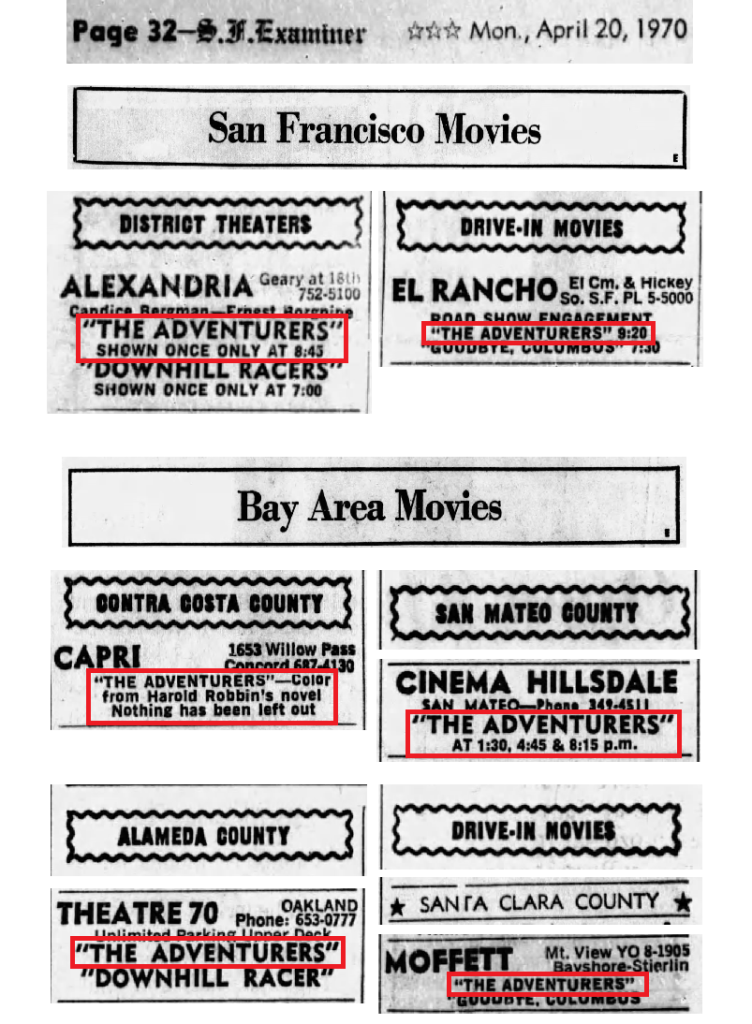
The conjunction of the screenings of the film with Fehmiu in San Francisco and the letter from Zodiac and the belonging of BEKIM to one of the two reference groups already identified (ancient civilizations / contemporary cultural events) indicates that it could be the keyword at the origin of M.
Delving into the “Fehmiu” lead, it turns out that the third result of the search term “Bekim” in the 1970 newspaper editions on newspapers.com[36] is an article on page 10 of the San Francisco Examiner signed by Vernon Scott and dating back to three and a half months before the sending of the encrypted name of Zodiac[37].
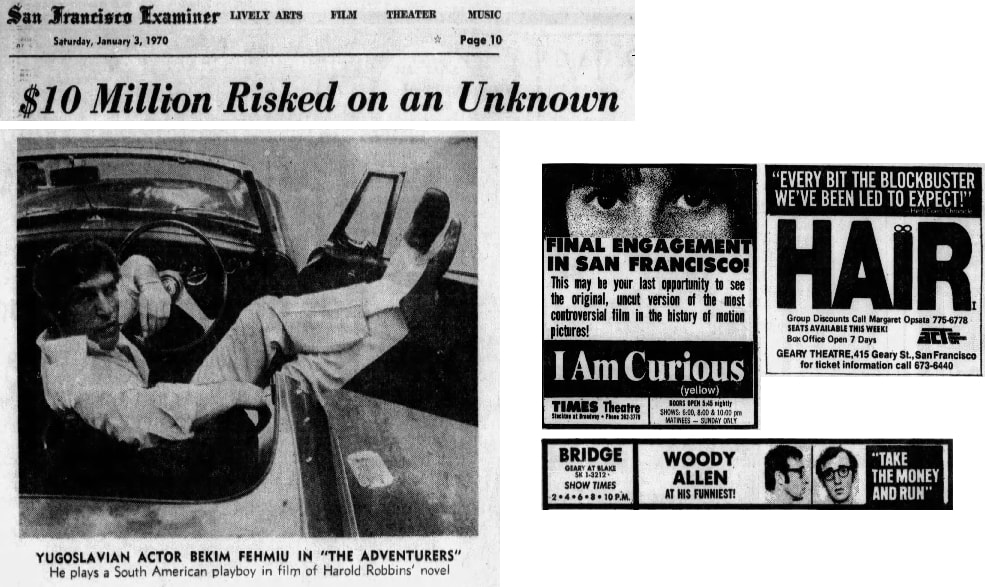
“Yugoslavian actor Bekim Fehmiu in ‘The Adventurers’
He plays a South American playboy in film of Harold Robbins’ novel”
Vernon Scott, San Francisco Examiner, 3 gennaio 1970, p. 10
On the same page (image above, right), in addition to the advertisement for “Hair”, there are ads for successful films such as “I am curious” and “Take the money and run”[38] which together with the title of the article recall (strangely?) the sentence under the cipher.

Now, it is revealed why Zodiac used the name of the interpreter of Ulysses as a keyword, by inserting an M after the part of the cipher corresponding to ANETHEKE.
“Bekim” is obtained by placing a B in place of the solar cross
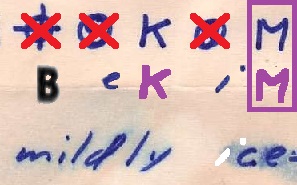
By replacing the K with a V, the sequence decrypted combined with the underlying phrase generates the sentence “bevi mildly”, ie “drink mildly”.
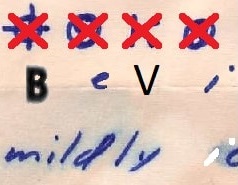
As predicted with the data from the 2010 census, the surname encrypted by Zodiac is BEVILACQUA, the first one in the United States for number of individuals containing the sequence ILAC and the word ACQUA[39].

The M/L substitution is also present in my decryption of the Mt. Diablo code

6. Take the money and run
ANETHEKE, the Zodiac watch brand, “Hair”, “Aquarius-Let the sunshine in”, BEKIM Fehmiu, a seal of Harappa and QUA-NAM are the sources used by Zodiac for writing the cipher.
One question remains. Why did Zodiac swap the N for the E in the word ANETHEKE?
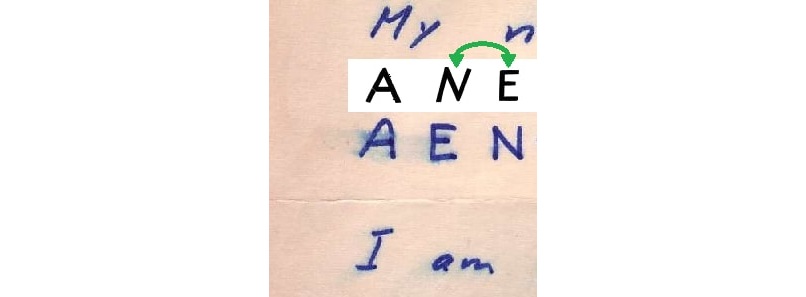
The sources of the cipher discovered so far have led to the assassin’s surname, of Italian origin, BEVILACQUA. Perhaps by identifying the reason for the exchange between N and E, it will also be possible to identify the meaning of the initial symbols, AEN.
The most common words in an English dictionary that begin with AEN, such as the cipher text of Zodiac, seem to be the Aeneid, the work of the Latin poet Virgil, and its protagonist, Aeneas[40].
In the Oxford Pocket Dictionary (1988), only “Aeneas” and “Aeneid” start with AEN

This observation and a reading of the news dating back to the week in which the Zodiac killed the taxi driver Paul Stine suggests that the swap of N and E may be based on a movie that the serial killer may have already been inspired by.
In early October 1969, a famous comedy that premiered in New York in August[41] and whose main character was called Virgil, like the author of the Aeneid, was screened for the first time in San Francisco[42].
The film ended with this punch line:
“Do you know if it’s raining out?“[43]
It is pronounced by New Jersey criminal Virgil Starkwell played by red and bespectacled Woody Allen in “Take the money and run”[44]. The film, shot entirely in San Francisco, was screened in the city for the first time on October 8, 1969, at the Bridge between Geary and Blake[45], a few blocks from where Stine was found dead a few days later. In the same week, “I am curious” also debuted at the Gateway, while “Hair “was performing at the Geary Theater[46].
On October 8, 1969, an article by Stanley Eichelbaum on the San Francisco Examiner read:
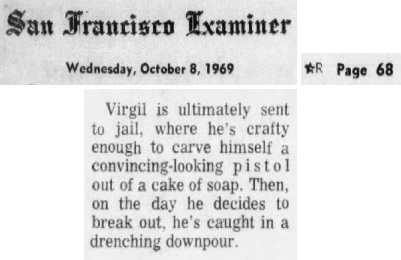
Stanley Eichelbaum, San Francisco Examiner, 8 Ottobre 1969
The rain is a disaster for the robber played by Woody Allen. And for Zodiac? What did he say in his letter with the ciphered name?

What was the killer alluding to? Perhaps, once again, to a keyword. And not only.
On the night of October 11, 1969, in Presidio Heights, San Francisco, while Zodiac was about to flee, he was seen by three teenagers who helped the police to make a sketch of him. Here’s how he looked like.


Zodiac, letter, November 9, 1970
“Take the money and run” ads dating back to few days before the Stine murder
“Woody Allen becomes a link in a prison chain gang in his new comedy ‘take the money and run’, opening next at the Bridge. Much of the film was made in the Bay Area.“

It seems quite obvious that the disguise Zodiac was referring to was that of Virgil Starkwell. On the other hand, the debut of the film in San Francisco had been widely publicized in the days of the Stine murder, almost as much as “Hair” and the film “I am curious”. At that time, the killer may have participated in the cultural life of the city. We learn it from the fact that, on October 18, 1969, ten days after the debut of “Take the money and run” at the Bridge, “The Mikado” operetta played by the Lamplighters would have debuted at the Presentation Theater[47].
Zodiac cited the play by Gilbert and Sullivan in 1970[48] and 1974, when, as seen, he used a passage as a signature[49].
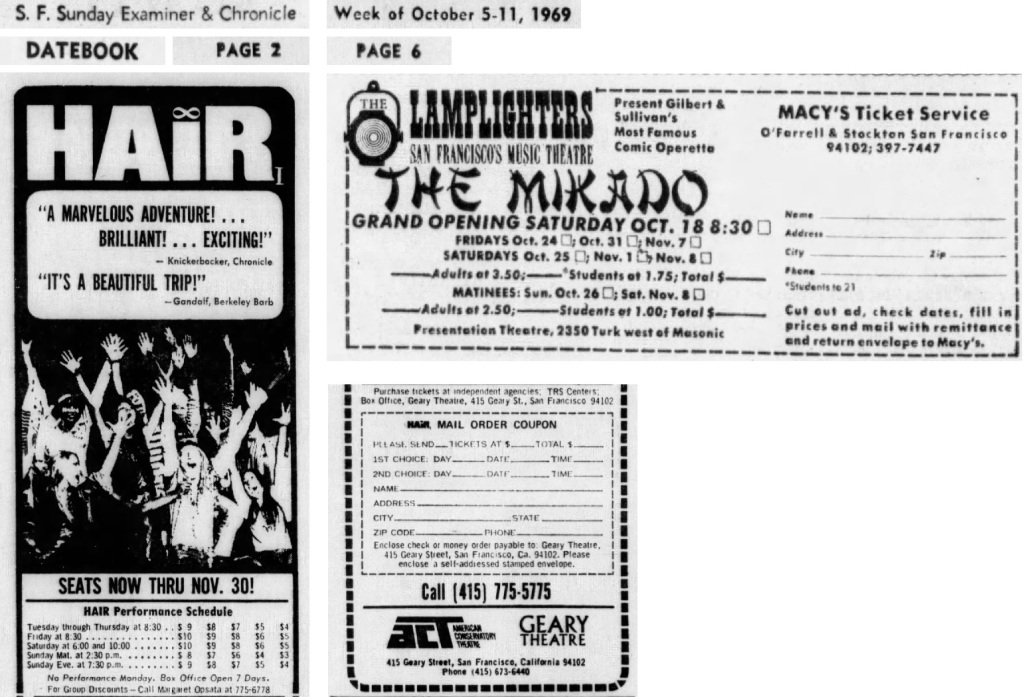
Passages from “Take the money and run”
Watch the video, clicking here.
The incipit of the movie is this: “In December 1, 1935, Mrs. Williams Starkwell, a wife of a New Jersey handyman gives birth to her first and only child. It is a boy, and they name it Virgil. He is an exceptionally cute baby, with a sweet disposition. Before he is 25 years old, he will be wanted by police in six states, for assault, armed robbery, and illegal possession of a wart”[50].
Virgil (Woody Allen) tries to escape from a prison with a bar of soap looking like a gun but he got caught as soon as it starts to rain and the gun liquefies[51].
He gets away after a vaccine test and met Louise (Janet Margolin). An excerpt from their dialogue follows:
Virgil: “Are you an artist?”
Louise: “No, of course not. I’m not an artist.”
Virgil: “No? Well, what do you do?”
Louise: “I’m a laundress”.
Virgil: “Laundress? Laundry?”
Louise: “Yeah. I wash clothes, in Maryland.”[52]
For other references to “wash” by Zodiac, click here.
Virgil tries to rob a bank but failed to make himself understood by the teller and goes in prison again, where he is put to work in a laundry too. He explains to Louise: “And uh, they got me. I misspelled a note.”
A few days later, he manages to escape taking a taxi.
The film ends with an interview with Virgil in prison while he is carving another bar of soap. As already said, the punchline of the bespectacled, reddish, New Jersey criminal is:
“I’m very skilled with my hands… Do you know if it’s raining out?”[53]
“Take the money and run” did not open in San Francisco until October 8, 1969[54]. However, already on Septemper 27, Zodiac “quoted” the movie when he told the victims a made-up story on his escape from prison[55], tying them with a washing line[56], and calling the police from a phone booth in front of a car wash[57] next to a laundry[58]. He should have been in Los Angeles[59] or outside of California[60] in the previous days for having been able to watch Woody Allen’s movie before the Berryessa attack.
As zodiacciphers.com reports, the phone booth of the Napa Car Wash where Zodiac called the police was next to the “Sam Kee Laundry”[61] at Main and Clinton Street[62] (see Google Maps). That can be added to the allusions to “Take the money and run”.
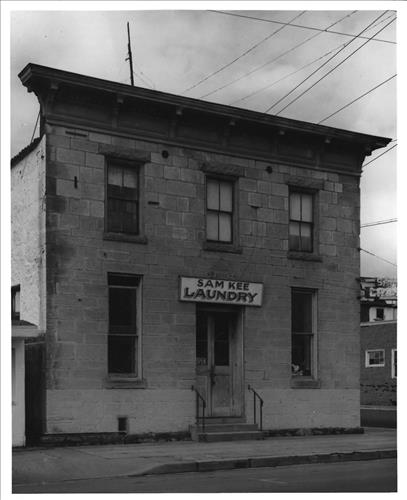
Photo by G. J. Golik – 1972
Two further links between Woody Allen’s work and Zodiac’s encryption
On September 21, 1969, not even a week before the attack at Lake Berryessa, the Woody Allen Show saw the participation of Candice Bergen, Bekim Fehmiu’s wife in “The Adventurers”[63], and the Fifth Dimension[64].
“21.00 – 5 – Special: ‘Woody Allen Show’. The rev. Billy Graham joins Woody in a question and answer period with the audience. Candice Bergen performs with Woody in an off Broadway rehearsal of a scene to be costumed in the nude, in a silent movie spoof, and as a dumb dame with an aged tutor. The Fifth Dimensions group sings.“
San Francisco Examiner & Chronicle, September 21, 1969
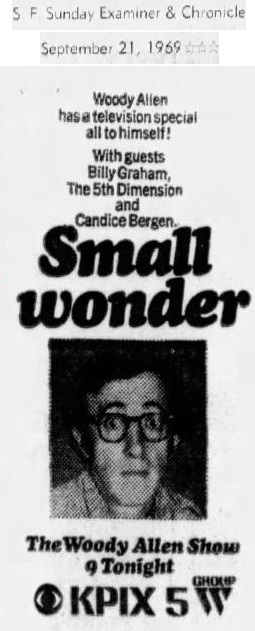
How come Zodiac should have mentioned Woody Allen? Perhaps for esteem. Or perhaps because Allen’s first play on Broadway was titled: “Don’t drink the water”[65].
The movie based on that work premiered at the cinema “Alexandria” in San Francisco (the same as “The Adventurers”) in November 1969[66].
“An incredibly witless movie has been made of Woody Allen’s stage comedy. ‘Don’t drink the water,’ which was flimsier than a pastry puff but did at least contain a measure of frightfully funny humor.“
Stanley Eichelbaum, San Francisco Examiner, November 20, 1969

7. Joe

Having ascertained that Zodiac may have decided to replace ANE with AEN in ANETHEKE for the reference to the name Virgil, we can proceed to examine, in a much more prosaic way, English names with three letters that have an N as second letter or end in E.
The swap, in fact, may have been decided simply for that reason. According to nameberry.com, there are only two classic English male names with an N as the second letter: Eno and Enu. Conversely, many names end with E[67].
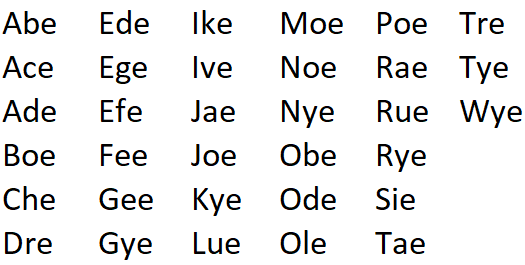
The swap N/E may indicates that N replaces a E.
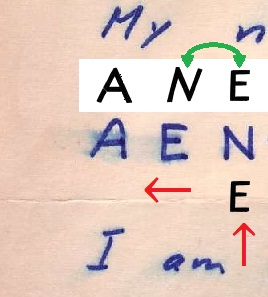
The underlying phrase of this part of the cipher message “I am” coupled with AEN and the decrypted E forms the horseshoe-shaped phrase: “I am Enea” (note: in the 340 cipher decrypted in December 2020, Zodiac used a transposition system based on the knight move in chess that approached the structure of this sentence). Enea is the translation of Aeneas into Italian[68].

Two more letters have to be decrypted
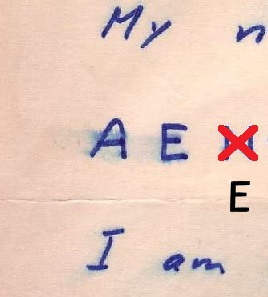
The final part of the decryption is suggested by Zodiac at the end of the second page of the letter, where he placed the last “I” above the equal sign in the equation: solar cross = I0 (image below)[69]. The word “I” translates “Io” into Italian[70].
10 o “Io”?
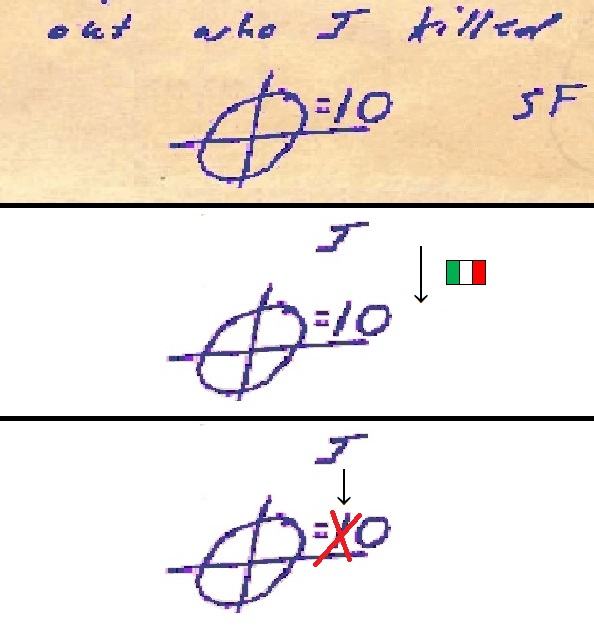
- If I → IO (in Italian)
- and J → I (as drawn by Zodiac)
So: I → IO → JO.
“I” (io) in the phrase below the plain text and the cipher could be read JO.
I am Joe
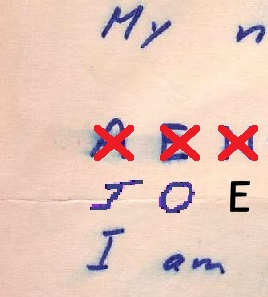
The J decodes the A in correspondence with the word “I”, io.
Zodiac’s name is JOE.
The O/J and I/O replacements in my decryption of the Mt. Diablo cipher could allude to this conclusion.

If you have taken a look at the “water theory”, you will also remember that the phone booth from which Zodiac first called the police was located at the Joe’s Union gas station in Vallejo[71].
The term “I”, the Italian “io”, was also the first encrypted word in the first Zodiac’s cipher[72], as Bettye Harden, one of the two solvers, had guessed, tells Robert Graysmith in “Zodiac”[73].
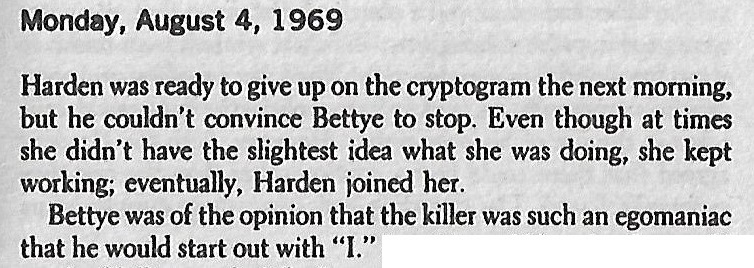
Robert Graysmith, Zodiac, p. 53
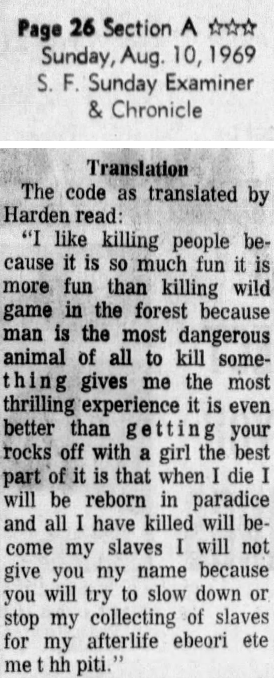
San Francisco Examiner, 10 agosto 1969
“My name is Joe Bevilacqua“

References
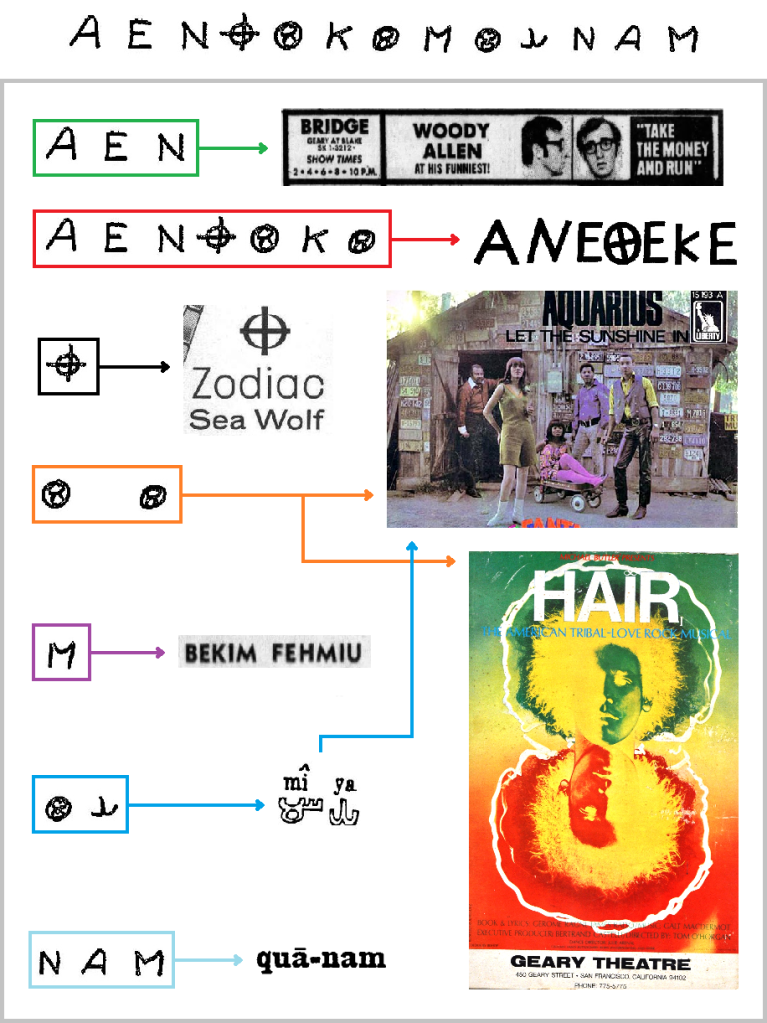
Endnotes part 1
[1] The Oxford paperback dictionary, 1988, p. 12, read the chapter “Take the money and run”.
[2] FBI Laboratory, report on specimens Qc45, Qc46, Qc47, FBI File n. 9-49911, April 28, 1970.
[3] FBI San Francisco, airtel, file 9-49911, Janyary 22, 1970.
[4] Zodiac, Halloween card to Paul Avery, October 27, 1970 (zodiackillerfact.com). My solution’s here.
[5] Frederic W. Goudy, The Alphabet, 1922, p. 11.
[6] Sunday San Francisco Examiner and Chronicle, California Living, week of November 12, 1967, p. 54. Several advertisements of Zodiac watches were published in U.S. newspapers in 1967. Source: newspapers.com.
[7] James Whitley, The archaeology of ancient Greece, Cambridge University Press, 2001, pp. 140-141.
[8] Hair, poster, A.C.T.’s Geary Theatre, San Francisco, 1969/1970.
[9] “5th Dimension gets Grammy”, San Francisco Examiner, May 8, 1970, p. 34. Source: newspapers.com.
[10] Mary Campbell, AP, “It’s a ripe age for the 5th Dimension”, San Francisco Examiner, June 6, 1969 (p. 26).
[11] California Department of Justice, Zodiac Homicides, special report, 1971.
[12] San Francisco Examiner, October 11, 1969, p.10. Several references int he following notes also. Source: newspapers.com.
[13] San Francisco Examiner, March 24, 1970, p. 24. Fonte: newspapers.com.
[14] San Francisco Examiner, October 11, 1969, p. 10. Fonte: newspapers.com.
[15] “Hunt for nurse at dead end”, San Francisco Examiner, September 26, 1970, p. 4.
[17] Alexander Cunningham, Corpus Inscriptionum Indicarum, Volume I, plate XXVIII. The description of the seal is on page 61.
[18] The Century Dictionary and Cyclopedia, Volume XI, The Century Co., p. 224.
[19] Ibidem, pp. 222-224.
[22] Andrew Ure et al., Dictionary of Chemistry, Vol. II, Robert Desilver, 1821, “Lac”.
[23] https://en.wikipedia.org/wiki/Sealing_wax.
[24] U.S. Census Bureau, Census 2010, surnames occurring at least 100 times, FILE B.
[25] Ibidem.
[26] Bevilacqua, en.wikipedia.org/wik/Bevilacqua_(surname).
[27] U.S. Census Bureau, Census 2010, surnames occurring at least 100 times, FILE B.
[29] Pliny the Elder, Naturalis Historia, Liber XI, paragrafo 137, la.wikisource.org/wiki/Naturalis_Historia/Liber_XI.
[30] Zodiac, letter to the San Francisco Chronicle, January 29, 1974.
[31] newspapers.com/search/#query=EKIM&dr_year=1970-1970.
[32] en.wikipedia.org/Bekim_Fehmiu.
[33] “Three films open this week”, San Francisco Examiner, March 23, 1970, p. 40. Source: newspapers.com.
[34] San Francisco Examiner, March 24, 1970, p.24. Source: newspapers.com.
[35] San Francisco Examiner, April 21, 1970, p.28. Source: newspapers.com.
[36] newspapers.com/search/#query=BEKIM&dr_year=1970-1970.
[37] Vernon Scott, “10 Million risked on an unknown”, San Francisco Examiner, January 3, 1970, p. 10. Source: newspapers.com.
[38] Ibidem. Source: newspapers.com.
[39] U.S. Census Bureau, Census 2010, surnames occurring at least 100 times, FILE B.
[40] The Oxford paperback dictionary, 1988, p. 12.
[41] Stanley Eichelbaum, “Woody the failure is a film success”, San Francisco Examiner, October 8, 1969, p. 69. Source: newspapers.com.
[42] S.F. Sunday Examiner and Chronicle, Datebook, October 5-11, 1969, pp. 1 and 13. Source: newspapers.com.
[43] Take the money and run, directed by Woody Allen, ABC, Palomar Pictures International, 1969. Source: https://www.youtube.com/watch?v=1RZ7vrkj5Xo, min. 8.21.
[44] Ibidem. See also the transcription here: script-o-rama.com/movie_scripts/t/take-the-money-and-run-script.html.
[45] S.F. Sunday Examiner and Chronicle, Datebook, October 5-11, 1969, p. 13. Source: newspapers.com.
[46] San Francisco Examiner, 11 ottobre 1969, p. 10, Source: newspapers.com.
[47] S.F. Sunday Examiner and Chronicle, Datebook, October 5-11, 1969, p. 6. Source: newspapers.com.
[48] Zodiac, letter to the San Francisco Chronicle, July 26, 1970.
[49] Zodiac, letter to the San Francisco Chronicle, January 29, 1974. See also FBI Laboratory, Cryptoanalysis on the January 29, 1974, letter, FBI File n. 9-49911, March 1, 1974.
[50] Take the money and run, directed by Woody Allen, ABC, Palomar Pictures International, 1969. Min. 0.10 of the following video: https://www.youtube.com/watch?v=hwNYbWnRlAo.
[51] Ibidem. Min. 1.06 of the following video: https://www.youtube.com/watch?v=hwNYbWnRlAo. “I was swamped out by the rain we had a little back”, wrote Zodiac allusively in his letter postmarked on December 20, 1970.
[52] Ibidem. Min. 2.14 of the following video: https://www.youtube.com/watch?v=hwNYbWnRlAo. See the references by Zodiac to “wash”, and the false story on his escape he told Brian Hartnell and Cecilia Shepard in the chapter “L’acqua”.
[53] Ibidem. Min. 8.24 of the following video: https://www.youtube.com/watch?v=hwNYbWnRlAo.
[54] San Francisco Sunday Examiner and Chronicle, Datebook, October 5-11, 1969, p. 13. Source: newspapers.com.
[55] Dave Smith, “Zodiac Killer, portrait of madness”, Los Angeles Times, October 15, 1969, p. 27. Source: newspapers.com.
[56] The Napa Register, October 1, 1969, first page. Source: newspapers.com.
[57] L. Pierce Carson, “Manhunt for crazed killer”, The Napa Register, October 4, 1969, p. 3a. Source: newspapers.com.
[58] Napa National Register of Historic Places. Link: https://npgallery.nps.gov/NRHP/GetAsset/NRHP/74000540_photos.
[59] Los Angeles Times, August 25, 1969, p. 29. Source: newspapers.com.
[60] Daily News, August 18, 1969, p. 57. Source: newspapers.com.
[61] Napa County Sheriff’s Office, Report on the Lake Berryessa attack, October 5, 1969, p. 1. See Google Maps.
[62] Napa National Register of Historic Places. Link: https://npgallery.nps.gov/NRHP/GetAsset/NRHP/74000540_photos.
[63] The Napa Register, October 1, 1969, first page. Source: newspapers.com.
[64] San Francisco Sunday Examiner and Chronicle, 21 settembre 1969, p. 5. Source: newspapers.com.
[65] John Chapman, “Woody Allen farce, ‘Don’t drink the water,’ stirs up laughter”, Daily News, November 18, 1966, p. 76. Source: newspapers.com.
[66] Stanley Eichelbaum, “Screen renders ‘Water’ non-potable”, San Francisco Examiner, November 20, 1969, p. 28. Source: newspapers.com.
[67] nameberry.com/baby-names/831/3-letter-boy-names/uniqueameberry.com.
[69] Zodiac, lettera al San Francisco Chronicle, April 20, 1970, p. 2.
[70] Collins Italian College Dictionary, 1991, p. 167.
[71] Vallejo Police Department, criminal report on the attack at Blue Rock Springs, 1969 (p.13).
[72] “Salinas teacher breaks code on Vallejo murders”, San Francisco Sunday Examiner and Chronicle, August 10, 1969, p.24. Source: newspapers.com.
[73] Robert Graysmith, Zodiac, Berkley Publishing Group, 1986, edition 2007, p. 53.

You must be logged in to post a comment.